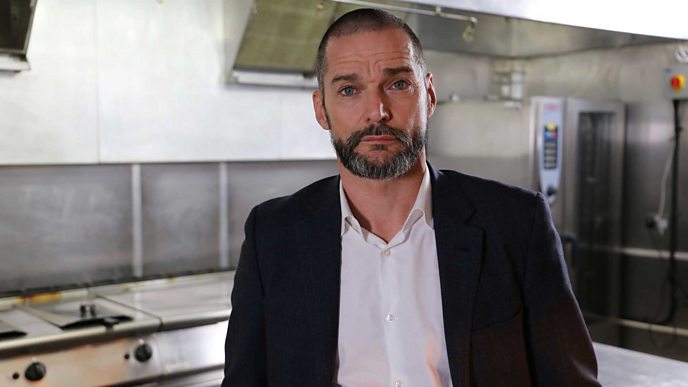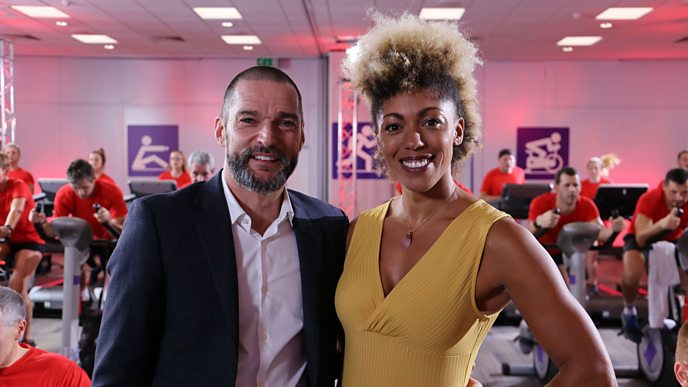In a new documentary, Horizon: The Restaurant that Burns off Calories, Fred Sirieix and GP Zoe Williams challenge people to confront how much exercise is required to ‘work off’ calories in a restaurant meal. Along the way, they discover how our relationship with food is altered when we’re across this knowledge. Here, the maitre d’ reveals what happened.
Does equating calories to exercise make us eat less?
The programme focuses on research published by Loughborough University. They pooled the results of previous studies to see if physical activity calorie equivalent (PACE) labelling on food could help in the fight against obesity. The idea is, if we are faced with the reality of what it’ll take to burn off that chocolate bar or indulgent main, we might be more likely to choose something healthier.
The results showed that PACE labelling could lead to people cutting up to 200 calories from their diet. Professor Daly, who led the study, explains: “The evidence shows that even a relatively small reduction in daily calorie intake (100 calories) combined with a sustained increase in physical activity is likely to be good for health and could help curb obesity at the population level. PACE labelling may help people achieve this.”
How does the restaurant burn calories on the show?

In a glass-fronted restaurant, we see couples, friends and families seated for lunch. What none of the participants know is that every meal choice they make has a direct impact on another group.
Downstairs are 25 fitness enthusiasts – on treadmills, exercise bikes and rowing machines. Together they have to burn off every calorie consumed in the restaurant.
Upstairs, diners choose their starter and main course, then later from the same menu, pudding. Then they are confronted with the same list of dessert options, but this time on a different menu with information about how long it will take to burn off each each option on the three different exercise machines if you were exercising at a ‘moderate pace’ (though there are of course, many reasons why the amount would differ depending on the individual). So, do the participants change their order? And how do they feel when at the end of the experiment they discover the gym, and the runners, cyclists and rowers inside it?
It is this unusual scenario that tempted Fred to take part in the programme. “It’s a very clever concept…. It makes you realise, ‘Oh my god, I’ve just had calamari and now I’ve got to be on the treadmill for 45 minutes to work it off’.”
How many calories are in the restaurant menu?
Not surprisingly, the takeaway-style food is some of the most calorie-packed, with burger and chips coming in at 1,123 calories, while roast chicken breast with mash and leeks in a creamy sauce is less at 760 calories.
But the all-important question is: how long does it take to burn off the puddings? The 788-calorie chocolate brownie with ice cream is said to require 69 minutes on a running machine, the sticky toffee pudding with sauce and clotted cream 39 minutes, and you’d apparently have to jog for 40 minutes to burn off the cheesecake, 11 for ice cream, and just six for the sorbet. The cheese board is the co-‘worst’ offender, with the same calories and exercise required as for the brownie.
Should food be labelled with exercise equivalents?

While some people stick with their pudding choice because they see eating out as a special occasion, others are so shocked by the exercise times that they change their order for a less calorific dessert.
This poses a moral question though: should people be able to enjoy eating what they want without having to look at such statistics or does the obesity crisis justify this shock-tactic?
There is of course a further issue which is important to consider, and one which The Royal Society For Public Health has addressed. It had previously explained that PACE labelling had “the potential to help moderate calorie intake”, but the organisation has since altered its stance.
“Activity equivalent labelling is something we have wanted to move away from, not just because it places responsibility on the individual, but also because we are very aware of the negative consequences it could have on some people. Although this type of labelling might make people think twice about what they’re eating, we would never want it to have a detrimental effect on those with eating disorders or mental health problems. However, research shows that on a population level, activity equivalent labelling could be one effective initiative to reduce obesity, and therefore we have not revoked the paper”.
Based on materials of BBC


















